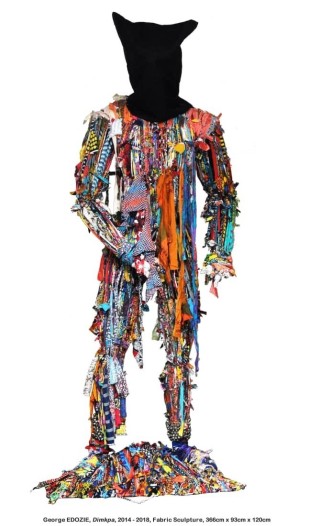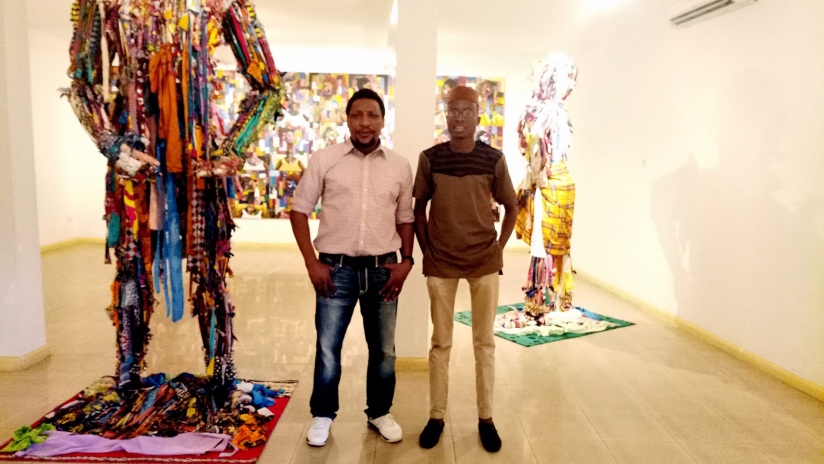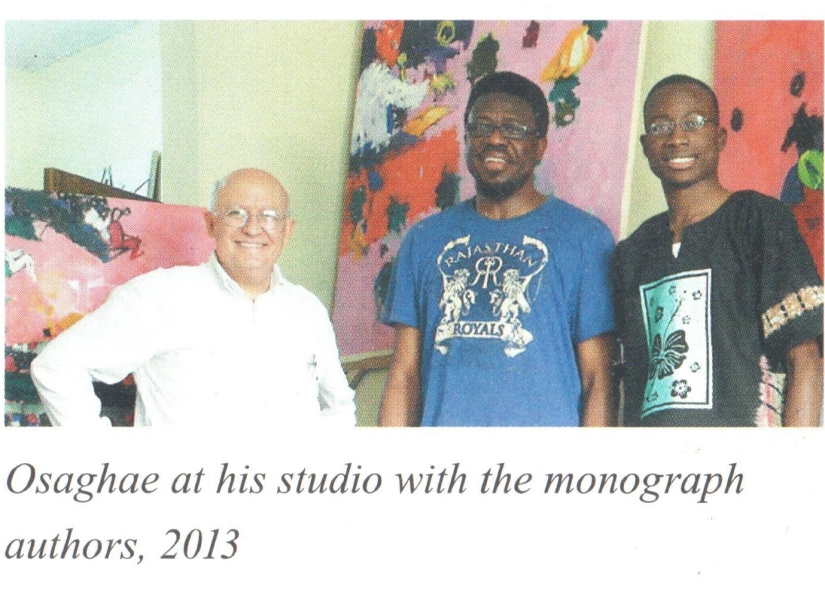What is the greatest asset of a good artist? I have probably been asked this question, more times than I care to recall throughout my decade long involvement in the arts –Contemporary and Modern Art of Nigeria. I struggle to answer such a partial query, as such artists are made of diverse things; the totality of which is often greater than the sum of these parts. My opinion may sound like a cliché Gestalt retort, but I do believe it to be true.
For does an artist’s worth abound in the value (monetary) of his oeuvre? Hardly so, art appreciates and loses market value as it gets exposed to extraneous factors that are oftentimes beyond the control and purview of the artist. Primary and secondary market forces, the dictates of the interplay of demand and supply, even the cold choking grasp of death, illness or oversaturation of the market all have varying degrees of effects on an ephemeral concept as worth or value. What about technical proficiency, or the ability to conjure up and express on canvas pertinent ideas, or address pressing social issues about his society? These have got to be important assets no doubt, and they are! Any artist or professional for that matter is as good as his ideas and how these ideas are expressed certainly matters. Nonetheless, when it comes to technique and artistic abilities, the world has seen its fair share of artists who apparently lack in technical skill, yet end up being successful in their careers. The same should hold true for copy artists who are gifted at replication, but cannot or would not task themselves to stir up their creative juices. Hence, at the risk of overthinking or simplifying the puzzling question, “influence” is often my answer!
Influence, or the artist’s capacity to have a lasting impact on others -his audience, contemporaries, the society at large, (for me) trumps skill, market worth or any other factor, which in their individual right still help define a popular artist. From a generic perspective, human society holds every person to this standard -influence transcends the artist or his portfolio; it applies to everyone. We all are in some way evaluated on the influence we command. Shifting gears back to the Nigerian art scene, if art enthusiasts are asked to name the artists they consider influential, many will reel off big names like Onabolu, Enwonwu, Barber, and many of the living legends that were once labelled the Zaria Rebels, and rightly so too. Not many will think to include living contemporary Post-Independence artists on their list though; perhaps a few or even none will. Yet, I dare say that an artist like George Edozie fits the bill.
A mid-career, middle-aged artist under 50 years of age like Edozie still has some way to go –a very long way actually and it seems a tall order to hold him next to the top art luminaries such as Enwonwu and other esteemed masters that Nigeria has produced over time. That is not my intention, however, if only one would examine the histories of many of these masters at any age comparable to Edozie’s, then the focus becomes clearer and the chasm seems not so wide after all. It can be likened to fate that Edozie would naturally aspire to be like Ben Enwonwu; both artists are Onitsha natives, from families with royal links, and perhaps more similar in their overt extroverted nature. They have both also been huge influences, especially in their circles, going on to inspire and influence a good following of artists. Of course, a young artist as Edozie has plenty left to achieve, but it is amazing as well as shocking to see the number of creative talents that have done more than borrow a leaf, “borrowed” and copied entire canvases, themes, and ideas from his oeuvre. Some of these artists, especially those he has mentored like Abayomi Sokenu, and the up comer Odia Odibo, etc., do it out of respect, paying tributes, or from semi-conscious adopted traits and trainings deposited in them, while few others choose to trail the fine line that may or may not be termed as appropriation, doing so without acknowledgement, or any perceived iota of conscience.

Influence comes with the experience and exposure of an artist with over 100 group exhibitions and 6 solos under his belt, one who has exhibited repeatedly on international platforms as the Art Basel Miami, and has some of his best works in notable collections as the Museum of Contemporary Art North Miami, The Indianapolis Museum, Studio Museum of Harlem, New York, and two upcoming private museums in Nigeria –The Yemisi Shyllon Museum, designed by Architect and art advisor, Jess Castellote, an initiative of the Pan-Atlantic University, Lagos, and the Chimedie Museum of Contemporary Art, by the King and traditional ruler of Onitsha, HRM Alfred Nnaemeka Achebe. George Edozie is more than an artist who influences others through his works only, he also proudly identifies as a curator and an astute art dealer, well known for helping younger, upcoming artists get their works into notable local collections. He has an entrepreneurial spirit, which serves him well in identifying business opportunities, he is the archetype Ibo-man* full of money-spinning ideas. In 2010, he signed a book deal, co-authoring 101 Nigerian Artists; A Celebration of Modern Nigerian Art with Engineer and fellow Art Curator -Ben Chukwuemeka Bosah. The book documents a cross-section of the portfolios of many contemporary artists in Nigeria. His profile boasts of an impressive number of exhibitions he has curated, while concurrently belonging to a handful of professional art organizations in Nigeria.
 Many who know him now might start to think that Edozie is larger than life, and while he seems pleased to appear so, things were not always as rosy. Choosing to be an artist from a young age, he graduated from the University of Benin in 1996 with a BA Hons in Fine and Applied Arts, far from being the best student in his class. He recalls with nostalgia, how he used to struggle as a painter, especially facing difficulty in mixing hues. His frustration with his challenge on the palette ultimately led him to experiment with infusing raw but “fabricated colours” to his canvas. This he achieved by adding pieces of coloured fabrics and cut-away remains of clothing from tailors and sartorial designers, to compensate for the tones that he could not attain. This technique he employs to date, morphing it over the years to create his line of vibrant three-dimensional sculptural works that are both imposing and grandiose in scale and execution.
Many who know him now might start to think that Edozie is larger than life, and while he seems pleased to appear so, things were not always as rosy. Choosing to be an artist from a young age, he graduated from the University of Benin in 1996 with a BA Hons in Fine and Applied Arts, far from being the best student in his class. He recalls with nostalgia, how he used to struggle as a painter, especially facing difficulty in mixing hues. His frustration with his challenge on the palette ultimately led him to experiment with infusing raw but “fabricated colours” to his canvas. This he achieved by adding pieces of coloured fabrics and cut-away remains of clothing from tailors and sartorial designers, to compensate for the tones that he could not attain. This technique he employs to date, morphing it over the years to create his line of vibrant three-dimensional sculptural works that are both imposing and grandiose in scale and execution.
Born in 1972, some of George’s earliest recollections to do with his creative side involved wondering into woods unsupervised, as a grade school pupil, to fashion out and collect toy props to play with. A somewhat lonely childhood, induced by virtue of his position as the last child in a family of six siblings, saw him being shipped between Abakaliki, Onitsha and Nsukka, all in eastern Nigeria, for his formative education. This did more to shape him into a creative, leaving him with a wild, curious and inventive imagination. He recalls witnessing Ben Enwonwu paint in public in Onitsha, being the unarguable biggest artist yet to hail from the eastern city by the Niger River and Nigeria as a nation. He would later naturally affiliate himself with a less older, more accessible, Onitsha artist; Olisa Nwadiogbu, who mentored him for a decade and deposited more in him than his love and involvement in music, his inclination to infuse symbolism into his art, his default choice of palette and the signature head tilt that characterizes most of his figurative forms.
 Edozie has a distinct portfolio of rather bizarre-looking figures, mostly entwined in some form of conscious pose for the viewer, accompanied by the angular head slant that he has owned and earned over time. While his works cannot be said to be visually unappealing, they can be seldom termed aesthetically pleasing all the time. Apparently, he seems not to pay attention to scale, proportions or real concepts like gravity, especially in his landscape series, yet his compositions are engaging and meaningful no less. Edozie’s artistic philosophy revolves around creating art that is personal (to him), or works that promote discourse on social issues; art that he and he only enjoys, to start with, believing that when he truly revels in his creative process, others will appreciate and take delight in the resulting output. Despite his high rate of artwork out-turn, this stance has so far worked for him, as he claims not to be swayed to create works that are uninspired by circumstances that he has not experienced.
Edozie has a distinct portfolio of rather bizarre-looking figures, mostly entwined in some form of conscious pose for the viewer, accompanied by the angular head slant that he has owned and earned over time. While his works cannot be said to be visually unappealing, they can be seldom termed aesthetically pleasing all the time. Apparently, he seems not to pay attention to scale, proportions or real concepts like gravity, especially in his landscape series, yet his compositions are engaging and meaningful no less. Edozie’s artistic philosophy revolves around creating art that is personal (to him), or works that promote discourse on social issues; art that he and he only enjoys, to start with, believing that when he truly revels in his creative process, others will appreciate and take delight in the resulting output. Despite his high rate of artwork out-turn, this stance has so far worked for him, as he claims not to be swayed to create works that are uninspired by circumstances that he has not experienced.
Many of Edozie’s paintings incorporate heavy layers of oil paint in multiple shades, smeared on the canvas surface with a palette knife, (less often thinly applied with soft brushstrokes), executed in insolated sections in whole or multiple parts, which give each piece a distorted and fractured feel. His technique and expression cannot be unique to him only, especially since artists in the same community end up being inspired by similar events. However, the execution of a similar idea by a different artist even in the same space, albeit with a different training or approach to his craft should ultimately end up being unique and perceived differently, but when such is not the case, it is hard not to take a critical look at which came first and who is towing the other. More recently, similar works that can pass off as copies of Edozie’s art have been trending online and within the art community, and while many frown at such, it appears no one wants to openly say anything or take a stance -so sad! When other known artist(s) attempt to replicate the hard-earned works of their celebrated contemporaries, the reactions and receptions to such are jarring as it feels unnatural, unoriginal and comes across as intellectual laziness, especially when such practice appears to be a recurrent pattern that has played out more than once with other notable artists. In a climate where appropriation can go unchecked due to specifically defined technicalities viz. the purpose and character of use (for commentary or commercialization), whether the copyrighted work is indeed protected, the degree to which the original work was copied, and the effects on the market value of the copied work, crying foul becomes difficult and frustrating. Silence, however, does not mean that there was no infraction! Mostly, the art community takes note and it is simply a matter of time before red flags start to pop up on the various past infringements.
 Edozie for many may have quirks that make him a difficult person to work with, especially with his bluntness and undisguised candour, but it is such exuberance of character that shines through in his art. Ultimately, George Edozie will continue to do what he does best as an artist, and whatever quality you might want to ascribe to it, he will remain an influencer to many in the contemporary Nigerian art scape, even if those influenced acknowledge his impact on their art or chose not to.
Edozie for many may have quirks that make him a difficult person to work with, especially with his bluntness and undisguised candour, but it is such exuberance of character that shines through in his art. Ultimately, George Edozie will continue to do what he does best as an artist, and whatever quality you might want to ascribe to it, he will remain an influencer to many in the contemporary Nigerian art scape, even if those influenced acknowledge his impact on their art or chose not to.

With George Edozie at his last solo exhibition -New Nigerian Conjectures
*Igbo-man











